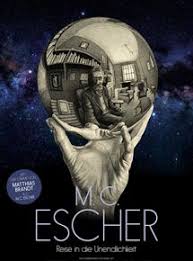![]()
Netherlands 2018
Opening October 10, 2019
Directed by: Robin Lutz
Writing credits: Marijnke de Jong, Robin Lutz
Principal actors: Documentary: George Escher, Jan Escher, Liesbeth Escher-Hogenhout, Stephen Fry, Matthias Brandt, Graham Nash
 The Dutch graphic artist himself would approve the beauty and balance of Robin Lutz’s documentary reflecting his meticulousness, exquisitely so in the realm of artwork. Structured around Maurits Cornelius Escher’s life story (1898–1972) with accompanying archival material, including Escher at work and interviews, its primary focus—artwork—is unwavering with awe-inspiring cinematography and animation. Siblings George, Jan, and Liesbeth Escher-Hogenhout provide aspects of inner-family dynamics, thus expanding on Escher’s accounts of the outside world he inhabited. An antidote from Graham Nash’s (Crosby Stills Nash and Young) conversation with Escher is most startling in its simplicity: “I’m not an artist, I’m a mathematician.”
The Dutch graphic artist himself would approve the beauty and balance of Robin Lutz’s documentary reflecting his meticulousness, exquisitely so in the realm of artwork. Structured around Maurits Cornelius Escher’s life story (1898–1972) with accompanying archival material, including Escher at work and interviews, its primary focus—artwork—is unwavering with awe-inspiring cinematography and animation. Siblings George, Jan, and Liesbeth Escher-Hogenhout provide aspects of inner-family dynamics, thus expanding on Escher’s accounts of the outside world he inhabited. An antidote from Graham Nash’s (Crosby Stills Nash and Young) conversation with Escher is most startling in its simplicity: “I’m not an artist, I’m a mathematician.”
In San Francisco, California during the 1960s the Hippie movement reconnected to Escher’s surreal work; adding psychedelic colors, endless quantities of products were marketed, albeit without Escher’s knowledge. Raised and schooled in the Netherlands by caring and wealthy parents, art teachers had an everlasting impact on Escher, as did Jutta Umiker when they met in Italy in 1923. Escher’s personality, like his timeless artwork, was a force unto itself. In his own words (Stephen Fry, voiceover) taken from letters, diaries and notes, Escher describes his adventurous journey through life. This is demonstrated by a pictorial account of influences, and artwork: inspirational landscapes and nature studies dissolve into an Escher woodcut. Inert designs and/or drawings come alive shifting, scrabbling and changing position; there are clips from films that borrowed from his vision.
While moving the film forward, the many designs taking on a fantastical life of their own is thanks to gifted animators and Mirage 3D VFX (special effects). Robin Lutz’s spectacular cinematography, Moek de Groot’s concise editing, and Bob Kommer Studios’ kinesthetic sound – all this with the most appropriately matched music makes one want to weep with joy.
Quite large, Snakes, 1969, represents everything M. C. Escher loved creating: interlocking patterns and symmetry shrinking to infinity that likely struck a premonitory nerve; the threefold rotational symmetry woodcut was his last. At some point, Escher remarks about his dream of making a film, and paradoxically, people finding it boring. It is fitting then, that Lutz has made Escher’s dream come true, while proving him wrong, since nobody will leave cinemas bored. 80 minutes (Marinell H.)
